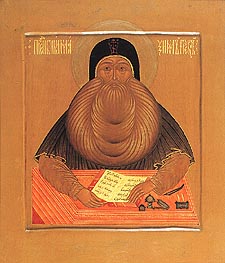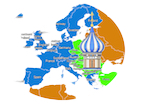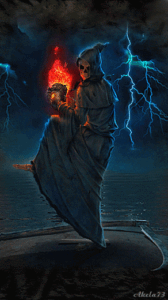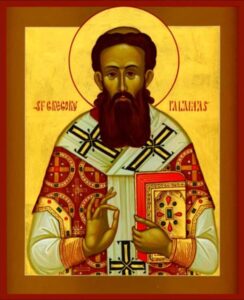St. Maximus the Greek
6 min read
by Dr. Vladimir Moss
St. Maximus the Greek was an Athonite monk who was sent, according to Sir Steven Runciman, “by the Patriarch Theoleptus I to Russia in response to [Great Prince] Vassily III’s request for a skilled librarian. Maximus, whose original name was Michael Trivolis, had been born in Epirus, at Arta, in 1480. During his travels through France and Italy in search of education he had arrived in Florence when it was under the influence of Savonarola, whom he greatly admired and in whose memory he joined the Dominican Order. But he was not happy in Renaissance Italy. After a short time he returned to Greece and settled on Athos, where he occupied himself principally with the libraries of the Holy Mountain. When he came to Russia the Great Prince employed him not only to build up libraries for the Russian Church but also to translate Greek religious works into Slavonic.”
St. Maximus believed in the lofty calling of the Muscovite Great Princes to lead the Orthodox world. In a letter to Basil III he wrote that he “could measure himself by the emperors Constantine the Great and Theodosius the Great, whose successor your majesty is”. But he was worried by the Muscovite state’s tendency to absolutism and caesaropapism. Moreover, writes M.V. Zyzykin, he “complained that among the pastors of his time there was ‘no Samuel’, ‘a Priest of the Most High who stood up boldly in opposition to the criminal Saul’, that there were ‘no zealots like Elijah and Elisha who were not ashamed in the face of the most lawlessly violent kings of Samaria; there is no Ambrose the wonderful, the Hierarch of God, who did not fear the loftiness of the kingdom of Theodosius the Great; no Basil the Great, whose most wise teachings caused the persecutor Valens to fear; no Great John of the golden tongue, who reproached the money-loving usurer Empress Eudocia’. In accordance with Byzantine conceptions, Maximus the Greek looked on the priesthood and the kingdom as the two greatest gifts given by the most High Divine Goodness to man, as two powers on whose agreement in action depended the happiness of mankind. Among the duties laid upon the representatives of the Church, he mentioned that they must by their most wise advice and stratagems of every kind… always correct the royal sceptres for the better, so that they should be alien to any fawning before secular power and should exert a restraining, moderating influence upon it. Maximus spoke of the superiority of the spiritual power over the secular…”
St. Maximus ruffled the feathers of some leading Russians by his correction of the errors in the Slavonic service books, which his enemies took to mean that he rejected the Russian saints who had used these books. This was the first salvo in the war that would lead to the Old Ritualist schism… Also, he criticized the Russian Church’s refusal to be in communion with Constantinople – he said that the Greeks had long since abandoned the uniatism of the council of Florence, so there was no longer any reason to refuse communion. As long as Metropolitan Barlaam, a follower of St. Nilus of Sora, was in power, Maximus’ criticisms were tolerated; but when Barlaam was uncanonically removed by the Great Prince Vasily III and replaced by Metropolitan Daniel, a disciple of St. Joseph of Volokolamsk, his woes began…
For a while the Great Prince continued to protect him, even when he rebuked the vices of the nobility, the clergy and the people and supported the position of the non-possessor monks against the metropolitan. However, his enemies found the excuse they were looking for when the Great Prince, with the blessing of Metropolitan Daniel, put away his wife, the beautiful Solomonia Saburova, for her barrenness and married Elena Glinskaya. Solomonia objected strongly, but was forcibly tonsured in Suzdal and was later canonized under her monastic name of Sophia.
St. Maximus immediately rebuked the Great Prince. He wrote him an extensive work: Instructive chapters for right-believing rulers, which began as follows: “O most devout Tsar, he is honoured as a true ruler who seeks to establish the life of his subjects in righteousness and justice, and endeavours always to overcome the lusts and dumb passions of his soul. For he who is overcome by them is not the living image of the Heavenly Master, but only an anthropomorphic likeness of dumb nature.”
The saint was to suffer many years in prison because of his boldness. During this time he composed a famous canon to the Holy Spirit. He continued, even in prison, to have many admirers and supporters both within and outside Russia.
In confirmation of the exhortations of St. Maximus, Patriarch Mark of Jerusalem, wrote prophetically to the Great Prince: “If you do this wicked thing [marry Elena Glinskaya], you will have an evil son. Your estate will become prey to terrors and tears. Rivers of blood will flow; the heads of the mighty will fall; your cities will be devoured by flames.”[1] The prophecy was fulfilled with exactitude in the reign of his son, Ivan IV, better known as “the Terrible”…
Ivan’s childhood was very troubled. As Nicholas Riasanovsky writes, he “was only three years old in 1533 when his father, Basil III, died, leaving the government of Russia to his wife… and the boyar duma. The new regent acted in a haughty and arbitrary manner, disregarding the boyars and relying first on her uncle, the experienced Prince Michael Glinsky, and after his death on her lover, the youthful Prince Telepnev-Obolensky. In 1538 she died suddenly, possibly of poison. Boyar rule – if this phrase can be used to characterize the strife and misrule which ensued – followed her demise…
“All evidence suggests that Ivan IV was a sensitive, intelligent, and precocious boy. He learned to read early and read everything that he could find, especially Muscovite Church literature. He became of necessity painfully aware of the struggle and intrigues around him and also of the ambivalence of his own position. The same boyars who formally paid obeisance to him as autocrat and treated him with utmost respect on ceremonial occasions, neglected, insulted, and injured him in private life. In fact, they deprived him at will of his favourite servants and companions and ran the palace, as well as Russia, as they pleased. Bitterness and cruelty, expressed, for instance, in his torture of animals, became fundamental traits of the young ruler’s character.”[2]
In the opinion of some, Ivan’s later cruelties can be explained, at least in part, by mental illness induced by the extreme insecurity of his upbringing. However that may be, there is evidence that Ivan was both cruel and debauched, not only to animals but also to human beings, from an early age…[3]
St. Maximus appealed to Ivan to release him from prison, saying that he was placed by God “in His place, as tsar, sovereign and master on earth, in order to govern His inheritance, Orthodox people, with all righteousness and God-pleasing forethought for them” – including himself. The tsar released the saint, who continued his bold preaching. Thus he refused to bless a pilgrimage of Tsar Ivan, saying that he should look after the widows and orphans of those killed at Kazan instead. And he threatened that if he did not, his newborn son Demetrius would die. Ivan ignored his advice, and Demetrius died…
By the time of his blessed repose, St. Maximus was honoured by the whole of Russia. He was glorified by many miracles, and was buried in the Holy Trinity – St. Sergius monastery. He is commemorated on January 21.
[1] Francis Carr, Ivan the Terrible, London: David & Charles, 1981, pp. 61-62.
[2] Riasanovsky, A History of Russia, Oxford University Press, 2000, pp. 143-144, 145.
[3] Henri Troyat, Ivan the Terrible, Sevenoaks: New English Library, 1985, pp. 16-18.
ReplyForward





